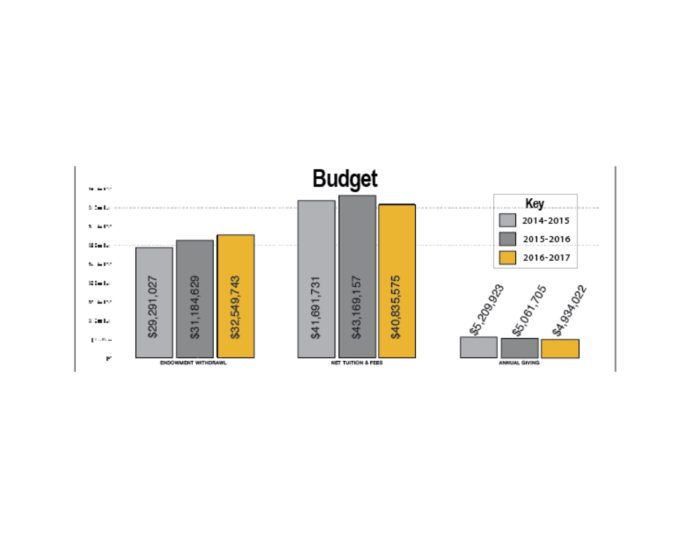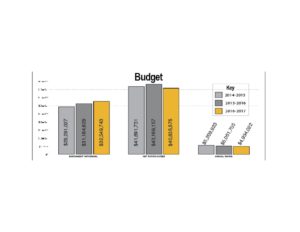

Capital projects are being delayed as DePauw University struggles to stabilize its financial future.
President Mark McCoy said at the September faculty meeting the current business model DePauw is using is not sustainable for the future. Currently, DePauw is drawing from the endowment at 6.35 percent, which is an over a percentage point higher than the recommended 4 to 5 percent. “This year we’re drawing six percent, which is, long-term for DePauw, not the best way to go,” John Carrigan, budget director, and controller said.
That means some building projects, like the renovation and expansion of the Roy O. West library, will be delayed two years to 2020. Other projects, such as the renovation of the Tenzer Technology Center and upgrading of dorms, will have to wait.
“It’s hard to do triage when everything is a head gaping wound,” President McCoy said.
According to Carrigan, a higher withdrawal from the endowment is used to cover operating costs that are not covered by net tuition and the annual giving fund.
The capital renews and replaces budget has been affected by current budget concerns. “This goes towards fixing our buildings and upkeep, which is much lower than it should be,” said Carrigan. “If you look at our financial statements, each year our depreciation is $11 million and that’s what we should be spending on our buildings. Right now we’re only spending about $2 million.”
President McCoy said current projects like the $18 million library renovation are being pushed back. The Tenzer Center was introduced to the DePauw community in May 2017 with hopes to complete the project by 2020.
“The gift from Don (‘61) and Barbara Daseke has always been slated for 2020,” President McCoy said. The plan was to fund the beginning of the project through the operations budget and pay the school back once the gift came through in 2020. President McCoy said they cannot do this because of a board policy stating the project cannot start until a certain percentage of funds are in the University’s hands.
Warren Whitesell, associate vice president for facilities management, said this policy has been waived in the past, but President McCoy said the later start date will allow for a better approach. “More deferred maintenance can be addressed with a later start date and the building can now be [environmentally] greener,” President McCoy said.
Another project being affected by the lack of budget funds are the first-year dormitories. President McCoy said the University has not taken the first step to renovating the dorms because of the exorbitant costs. However, a meeting will take place in January to discuss the option of taking on more debt to finance the project.
President McCoy said a potential plan will come forward in February with a timeline for the project.
According to Carrigan, DePauw’s operating budget for the 2017-2018 school year is running at $111 million in expenses. These expenses are broken up into four categories: salaries, wages, and benefits; non-salary operating expenses; debt service and the capital renew and replace budget.
Salaries, wages, and benefits make up the biggest part of the operating budget at 55 percent. The amount spent in this part of the budget changes year to year due to faculty and staff changes, as well as changes in benefits. Carrigan said every employee received a 3 percent increase in their salary and the University paid more money in health benefit claims.
Non-salary expenses make up 35 percent of the budget. These expenses go towards paying for supplies for classrooms and buildings, as well as utilities. Carrigan said the non-salary expenses have stayed flat over the last five years. “We feel like we’ve cut the non-salary budget down as far as it can go. It hasn’t increased over the last five years, but we haven’t decreased it either,” said Carrigan. “The last thing we want to do is cut programs and anything that affects the student experience negatively.”
The debt service includes the long-term debt DePauw pays on monthly. Carrigan said it makes up 8 percent of the operating budget. The renew and replace budget makes up the final 2 percent of the budget.
The expenses of the operating budget are covered by three categories of revenue: endowment withdrawal; net tuition and fees; and the annual giving fund. The University relies on the net tuition and annual giving fund to cover as much of the expenses as possible and the rest will be covered by an endowment withdrawal.
According to Carrigan, the net tuition DePauw receives has been going down. Net tuition is the amount of money DePauw students pay after scholarships and grants are gifted. For the 2016-2017 school year, DePauw received $40,835,575 in net tuition and fees. This amount is lower than both the 2014-2015 and 2015-2016 school years.
The annual giving funds are donations made annually to the University. Almost $5 million was donated to the University in the 2016-2017 school year, which was lower than both years prior.
Carrigan said it would take decades for DePauw to go under financially, even with the high withdrawal rate from the endowment. “Letting the extra percent sit in the bank allows it to grow interest and at $644 million, that’s a lot of money,” Carrigan said.
Last school year, some DePauw faculty and staff members were approached with a voluntary retirement program (VRP). Jana Grimes, executive director of human resources, said the program is a one-time thing.
The VRP was offered to 100 staff members and 36 took the program. Grimes and Carrigan said facilities saw a high impact from the VRP. Whitesell said 27 facilities members took the VRP, which has made facilities rethink the way they do their work.
The University will not know the financial impact of the VRP until the end of the 2017-2018 fiscal year.
Looking forward, Carrigan said DePauw’s non-salary budget may move to a zero-based budget. This means University departments would start at zero dollars in the budget process and receive funding based on their programs in the school year. “When you do this it makes you think a little bit more about what you need,” Carrigan said.
Carrigan said moving to a zero-based budget would help recognize some savings. “It makes you think, ‘Do we absolutely need this? Is it critical for DePauw?’ and if it’s not going to affect the student experience negatively, then odds are it’s not mission critical,” Carrigan said.
President McCoy said the University is not willing to take shortcuts to resolve the problem. “We are committed to the transformative education, the students and the faculty and staff,” President McCoy said. “We want to make sure this DePauw experience is available to students in 2057 and 3027.”


